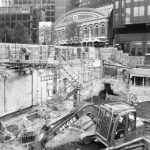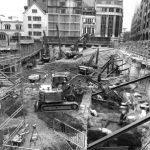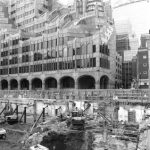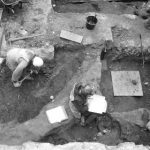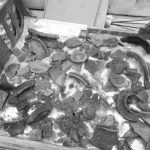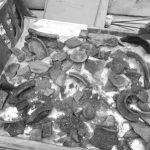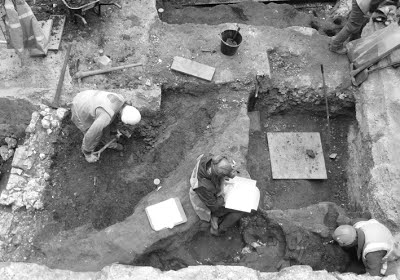
o. 507 JUNE 2013 Edited by Stephen Brunning
HADAS DIARY 2013
Tuesday 11th June @ 8pm: Annual General Meeting. Please refer to last month’s newsletter which included the AGM papers. (A limited number of spare copies will be available at the meeting). Do make sure you come along and support HADAS!
Sunday 15th to Thursday 19th September. Buxton Trip. Please see February newsletter for details, or contact Jim & Jo Nelhams. (020 8449 7076). The cost is £450pp sharing a double/twin room, or £495 for singles. There were still a couple of vacancies as this newsletter went to press.
Tuesday 8th October @ 8pm: Brunel’s tunnel under the Thames. Lecture by Robert Hulse – Director of the Brunel Museum.
Tuesday 12th November @ 8pm: The Lions on Kunulua – excavations of Early Bronze and Iron Age periods at Tell Tayinat, Hatay, Turkey. Lecture by Dr Fiona Haughey.
Sunday 1st December: Christmas Party at Avenue House, 12 noon – 4.30 pm (approx.) A buffet lunch. Price £25 to include one drink. Cash Bar. Booking details coming soon.
The 2014 lecture series is currently being planned. As usual they will be at 8pm on the second Tuesday in the month: 14th January, 11th February, 11th March, 8th April, 13th May, 10th June (AGM), 14th October and 11th November. As each talk is confirmed it will advertised in this section of the newsletter, but don’t forget to keep the dates free!
All Lectures are held at Avenue House, 17 East End Road, Finchley, N3 3QE, and start promptly at 8.00 pm, with coffee /tea and biscuits afterwards. Non-members welcome (£1.00). Buses 82, 125, 143, 326 & 460 pass nearby and Finchley Central Station (Northern line) is a short walk away.
HADAS committee members URGENTLY required!
Our constitution allows for 12 committee members in addition to the officers. Last year we had 9 but this year only 6 have offered themselves for re-election. Though the enthusiasm for coming on all-day visits to archaeological and historic sites remains, we do not now have enough people prepared to arrange these visits. We therefore need more members to come forward, keep HADAS the vibrant and active local archaeological society it is and help shape its future. Some of us have been on the committee for many years and we urgently require “new blood” with fresh ideas so that HADAS can remain at the forefront of Voluntary & Community archaeology. A couple of our officers have also expressed a wish to retire, and if the current rate of decline continues we are at risk of dissolution after 52 years in existence! PLEASE, PLEASE consider joining the management committee. The Committee meets five times a year, in the evenings. Come along to the AGM and speak to either myself (Stephen Brunning) or Chairman Don Cooper. The constitution allows for nominations at the meeting. You can also telephone me on 020 8959 6419 beforehand. We desperately need your help!!
Notes and Queries by Ann Saunders
From the 1870’s William Morris travelled and stayed in Leek in the Peak District to work with a man called Thomas Wardle, who had travelled to India to study the dyeing and weaving of silk, about which he was passionate, and, in particular, to study the intricacies of the use of woad, a peculiarly difficult skill.
Before long Morris began to entrust his designs to Wardle; the firm has an archive of some 4,500 vintage designs on metal rollers, not necessarily all by Morris. The association continued after Morris’ death in 1896 and the firm continued to exist for another century, but lack of demand closed it down in the 1990’s along with other industries in the town.
A decade into the present century, Bonsoir of London, established in 1926 and now England’s oldest specialist retailer of luxury nightwear were looking for a printed silk supplier. By chance, Deborah Price, head buyer for Bonsoir, was told of the firm by a friend living in Leek. Contact was made and the firm are now printing again.
Might this make a good expedition for when HADAS are in Buxton?
Current Archaeology Backnumbers
HADAS member Jean Lamont has a collection of magazines she wants to give away free to a good home. They start at number 148 to the present issue. If you would like to take the entire set off her hands, please telephone Jean on 020 8449 7711.
Copped Hall Fieldwork
The Copped Hall Trust Archaeological Project (CHTAP) is carrying out a programme of excavations on the site of the earlier mansion (“old” Copped Hall), which stood at the northern end of the gardens and was demolished in 1748. The site is mainly Tudor but there are finds from all periods from the modern back to medieval, Saxon, Roman and prehistoric times (the Iron Age and earlier). Copped Hall is located near Epping, Essex.
In July 2013 the CHTAP will be running three Taster Weekends, each one aimed at teaching beginners the absolute basics of archaeology and excavation.
The dates will be as follows: Saturday 13 and Sunday 14 July, Saturday 20 and Sunday 21 July, Saturday 27 July and Sunday 28 July.
Each weekend will include presentations by a professional archaeologist on methods of investigation and on finds, but the aim of the weekend will be for students to spend the great majority of their time on actual excavation.
Cost of each weekend will be £50.
In August 2013 two five-day Field Schools will be held for those who have already learned the basics of excavation and recording, either at Copped Hall or elsewhere, and wish to develop their skills further. The aim of the schools will be to advance the archaeology of old Copped Hall.
The Field School dates will be as follows: Monday 6 – Friday 9 August; Monday 12 – Friday 16 August inclusive.
Weather permitting; the students will work in the trench all week under the direction of professional archaeologists, assisted by supervisors who know the site very well.
Certificates will be awarded to those who complete each School.
Cost of the Field School will be £90 for the week.
Bookings must be for a whole Taster Weekend or a whole Field School (not single days)
For more information or to make a booking, please contact:
Mr Andrew Madeley,
27 Hillcrest Road, South Woodford, London E18 2JL.
Tel: 020 8491 6514
Email: coppedhalldigs@weag.org.uk. Website: http://www.coppedhalltrust.org.uk
May Lecture – 10,000 Years of History beneath your Feet: the Bankside
Foreshore. Review by Peter Pickering
Fiona Haughey’s lecture at our May meeting gave us even more than it said on the tin – 10,000 years indeed, but going far further up- and down-stream than the Bankside foreshore. Fiona explained that the Thames river system until recent times had been much more than the single mighty river we see to-day – rather a river with several channels and many streams running into it (the ‘lost rivers of London’); its course in Mesolithic times was well south of the present one. Erosion is continuing apace, as dredging makes the banks slump into the river, speeding catamarans wash the foreshore away, and the mitten crab burrows uncontrollably; the effect on stratigraphy is that earlier deposits may lie above later ones, having fallen on them when eroding from the banks. In Roman times high water was two metres above low water; the range is now eight metres. The foreshore that Fiona now studies is very different from that of which Ivor Noël Hume produced a map (which she showed us) in 1949. Submerged forests and hidden structures (fish traps, causeways, a ‘gridiron’ frame of
parallel wooden beams for supporting a barge, etc.) have appeared and disappeared again, when washed away or pilfered. Fiona reminded us that changes since the war have certainly not been all deleterious – the Thames used to be a virtually dead river, but is now teaming with wildlife.
Fiona regaled us with slides of the enormous quantity of things she has retrieved from the foreshore. They ranged from flints and handaxes, through quantities of weapons (Bronze Age, Viking, Second World War), clay pipes, wig curlers, bottles, to Hindu votive
offerings. And, of course, quantities of pieces of pottery and kiln furniture. But not coins; Fiona is not into coins, which might be legally treasure, and are the target of unscrupulous metal-detectorists. As well as slides, Fiona brought many examples of her finds for us to study, particularly inscribed clay pipe bowls and bottles with lettering. Fiona made the important and, to me, new observation that the fashionable explanation of some foreshore finds, that they were ritual offerings to the river or divine powers connected to it, failed to take account of the fact that many of them had been deposited on dry land which had just eroded into the water.
A tribute to Mary O’Connell by Tessa Smith
I made friends with Mary O.Connell through HADAS when she had just retired from teaching Domestic Science. She was great fun, interested in everything and looking for something to occupy her lively mind. She qualified as a Blue Badge Guide at St Pauls Cathedral and her particular patch of London was Clerkenwell. She loved finding out the quirky and unusual aspects of places and with her ability to communicate she soon became a very popular guide. She led many walks with HADAS -the Whitechapel Bell Foundry – Sadlers Wells where we all peered down the actual well backstage – the old Operating Theatre and museum, and the Thomas Coram Foundation foundling hospital to name a few.
We loved every walk because Mary always managed to discover such funny and interesting things, and she told them with such a twinkle in her eye and infectious chuckle.
When she moved to Taunton to be nearer to her daughter she still kept closely in touch with her London friends and I enjoyed her warm hospitality both in her bungalow in Taunton and her cosy home in Colindale. She was a very talented lady.
LAMAS Local History Committee also needs you!
The LAMAS Local History Committee is on the lookout for new members to represent the views of local history societies in the Greater London area. The committee meets three times a year and in between members carry forward the decisions of the committee. If you are interested or know of someone who maybe willing to join the committee please get in touch with John Hinshelwood 0208 3483375 (johnhinshelwood@btinternet.com) or Eileen Bowlt, 01895 638060, (c.bowlt@tiscali.co.uk).
First World War Centenary by Peter Pickering
2014 will be the centenary of the First World War. As Diane Lees, the Director of the Imperial War Museum has said, “The First World War was a turning point in world history, claiming the lives of over 16 million people across the globe. Almost all of us have a connection to it, whether it’s through family history, links to our local community or because of its far-reaching impact on the world we live in today.”
Last month, on 15th May the Heritage Lottery Fund (HLF) launched “First World War: then and now”, a £6 million small grants programme to help communities mark this centenary. HLF is making at least £1 million available per year for six years until 2019. It will provide grants between £3,000 and £10,000 enabling communities and groups right across the UK to explore, conserve and share their First World War heritage and deepen their understanding of the impact of the conflict.
Do members think HADAS should do something special to mark the centenary next year? If so, please let me know by telephoning 020 8445 2807, email pe.pickering@virgin.net, or express your views at the AGM.
COLAS site visit to 64-74 Mark Lane, EC3. By Bill Bass.
This was a dig carried-out by Museum of London Archaeology (MOLA) at 64-74 Mark Lane and 5-12 New London Street (opposite St Olave’s Hall). The visit was on behalf of the City of London Archaeological Society. Our group was met by MOLA Senior Project Manager Stewart Hoad and together with Site Supervisor Andy Daykin we were given a tour of the excavation. Room was tight so we could only look down from an adjacent access gantry – no comfy portacabin here. At the time of visiting on 20th May the dig was in its last week, so the work was concentrated in a busy north-west corner of the site. While the existence of an underground car-park ramp and basements had truncated much of the later archaeology, the bottom of features and deposits still produced some good evidence. Some photos taken on the day:
Mark Lane looking East
Mark Lane looking South
Mark Lane looking West
Mark Lane dig – Hearth
Mark Lane dig – Roman Pot
Roman
This area has been well studied over the years; i.e. sites on Fenchurch Street, at Lloyd’s Register, Plantation House and Dunster Court and others, so there was a fair expectation of what could be found. It is thought that the area had early Roman occupation consisting of an E-W road to the south of our site, which was probably laid out in c AD 50, lined with clay and timber buildings. These were later rebuilt after the Boudican fire of AD 60/1 as houses, shops, and work-places. The early nature of the occupation is also indicated by boundary ditches and the lack of burials showing a pre-walled settlement.
Much of the Mark Lane deposits indicated the ‘backyard’ nature found to the rear of such workaday properties, with a tiled hearth, pits, post-holes and redeposited brickearth deposits being recorded. Finds included pot, glass and worked bone. We were shown a tray of Roman late 1st to early 2nd Century pottery from a particularly rich context, a mix of samian, greywares and decorated wares, like large pieces of a ‘poppy head’ beaker. Most of the other finds had been moved off-site for processing due to the lack of space.
Medieval
Mark Lane (aka Marthe Lane) is first documented in c 1200. From c 1170s to 1385 our site lies entirely within an area known as the Manor of Blanch Appleton and held by the Bohuns, the Earls of Hereford and Essex who held manor courts there. In 1385 the property was sub-divided which led to a change of use for the site. Mark Lane and Hart St would have been fronted with timber framed shops, with stone built cellars below and further upper storeys of residential units. The yard areas would have contained features such as communal wells, while cess and rubbish was disposed of in deep stone lined pits. Periodically these pits were scoured out.
Indeed, similar features to those expected were being dug, a wood lined barrel pit/well, a chalk lined cess pit and chalk walls. Earlier in the excavation an excellent complete example of a ‘baluster’ tulip shaped jug of the 13th to 14th century was found.
There was not much of the post-medieval to be seen but a 16th century brick and chalk cess pit was exposed, and interestingly, two plates have been found recently, inscribed with the text ‘St OH 1829’, these parish boundary plates are presumed to be associated with the Parish of St Olave’s.
Many thanks to Stewart Hoad and Andy Daykin of MOLA, for giving their time in a busy period and to Rose Baillie of CoLAS, for her organisation of another of these fascinating site visits. Thanks also to McAlpine Construction for kind permission to visit.
Bibliography: 64-74 Mark Lane, MoLAS Archaeological desk-based assessment, December 2006.
Other Societies’ events, compiled by Eric Morgan
Saturday 6th July. Barnet Museum and Local History Society. Coach outing to Paycocke’s, Coggeshall, Essex. Coggeshall dates back to early Saxon settlement. There is evidence of a Roman villa or settlement before then and the town lies on Stane Street. Roman coins dating from 31BC to 395AD have been found in the area. Paycocke’s is a house built c1500 and features elaborate wood panelling & carvings. It also features gates which may been from the nearby abbey. For details please contact Pat Alison on 01707 858430, email patron37@sky.com or telephone Barnet Museum on 020 8440 8066.
Tuesday 9th July, 7.45pm. Amateur Geological Society. The Parlour, St Margaret’s Church, Victoria Avenue N3 1BD (off Hendon Lane). Sinking Cities. Talk by Dr Tony Waltham (Geophotos).
Friday 12th to Sunday 14th July. Festival of British Archaeology. Enfield Archaeological Society. Dig at Theobalds Palace, Cedars Park, Cheshunt, Herts. Please contact Mike Dewbrey on 01707 870888 (office number) for more details, or see blog http://enfieldarchaeology.wordpress.com, or website http://www.enfarchsoc.org.
Saturday 13th to Sunday 28th July. Festival of British Archaeology. Museum of London, 150 London Wall EC2Y 5HN & LAARC, Mortimer Wheeler House, 46 Eagle Wharf Road, N17ED. The Secret Museum. Exclusive behind the scenes tours of stores & labs. Discover the secrets of our collections. Explore usually hidden spaces. ALSO Saturday 20th & Sunday 21st July. Visit Billingsgate Roman House & Baths. Lower Thames Street EC3.
Sunday 14th & Sunday 28th July. Festival of British Archaeology. London Canal Museum, 12-13 New Wharf Road, Kings Cross N1 9RT. Open Days. Includes an opportunity to descend the Ice Well. ALSO from Tuesday 16th July. Exhibition: The Gatti Empire. ALSO Monday 22nd July, 1.30-4.30pm. Digging Deeper Study Day. Mrs Marshall – Ice Cream Queen. Talk by Dr Annie Gray, food historian and ice cream expert. Discover the history, the flavours, the exquisite display & taste. £10 includes refreshments.
Tuesday 16th to Sunday 21st July. Festival of British Archaeology. Enfield Archaeological Society. Dig at Elsyng Palace, Forty Hall. Forty Hill, Enfield EN2 9HA. Please see contact details as above. ALSO Saturday 20th July, 2-3pm. Rainton Tour. Offers a look at the private and professional life of Sir Nicholas Rainton in his home. £8 (£5 concessions).
Until Sunday 7th July Mon-Fri (except Tues) 12-5pm, weekends 10.30am to 5pm. Harrow Museum, Headstone Manor, Pinner View, North Harrow HA2 6PX. Harrow on the Hill exhibition: Harrow’s Secret Heart. Discover the history, its people & buildings (includes details of the HADAS 2011 dig).
Saturday 27th & Sunday 28th July, 11am-4pm. CoLAS at the Tower. Foreshore access and public displays. Part of the Festival of British Archaeology. Activities in the open space, front of the Tower beside the Thames. Handle finds and visit tower beach. Free. ALSO from Thursday 4th July. Fortress Tower. The moat will be home to replica siege machines, archery, combat, cooking and games 14th century style.
Wednesday 31st July, 1-2pm. Museum of London, London Wall, EC2Y 5HN. Meet the expert. With Francis Grew (Senior Curator of Archaeology). Free.
Unfortunately some times were omitted in last month’s newsletter from some of the events. These times are as follows:
Thursday 6th June. St Pancras Old Church. The time is 7pm.
Friday 7th June. Chipping Barnet Library. The time is 6.30-7.30pm.
Monday 10th June. Barnet Museum and Local History Society. The time is 3pm.
Friday 21st June. Wembley History Society. The time is 7.30pm.
Thursday 27th June. Finchley Society. The time is 8pm.

